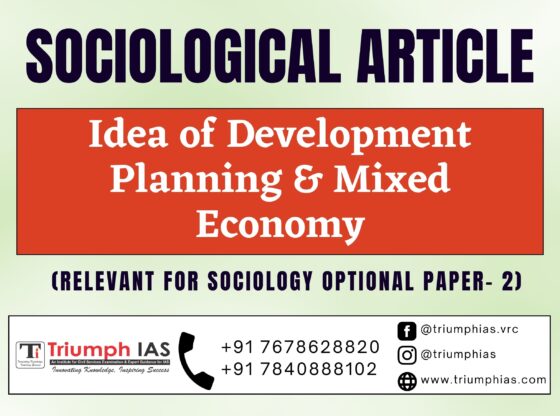Idea of Development Planning & Mixed Economy
Relevant for sociology optional Paper- 2 (Unit- 13 : Social Changes in India)

The idea of development planning and mixed economy has been an important concept in the field of sociology, particularly in the context of developing countries like India. The mixed economy model is a combination of both socialist and capitalist economies, where the government and private sector work together towards achieving a common goal of economic development.
Development planning is the process of creating a comprehensive plan to achieve a specific goal, usually related to economic or social development. It involves identifying the resources and infrastructure required to achieve the goal, as well as the strategies and policies needed to implement the plan effectively. The idea of development planning emerged as a response to the challenges faced by developing countries in the aftermath of World War II, as many countries sought to rebuild their economies and improve the standard of living of their citizens.
In India, the idea of development planning can be traced back to the early 1950s, when the country’s leaders sought to address the socio-economic challenges facing the newly independent nation. The government of India launched the first Five-Year Plan in 1951, which aimed to achieve rapid economic growth through a series of targeted policies and programs. The plan focused on key sectors such as agriculture, industry, and infrastructure, with the goal of improving the standard of living of the Indian people.
Over the years, India has implemented several Five-Year Plans, each with its own set of goals and objectives. These plans have been instrumental in transforming India from a primarily agrarian economy to a diversified, modern economy with a strong manufacturing sector. The plans have also helped to address some of the country’s most pressing social issues, such as poverty, unemployment, and inequality.
The mixed economy model has played a crucial role in India’s development planning efforts. In a mixed economy, the government plays an active role in regulating the economy, but the private sector is also allowed to operate and grow. This model has allowed India to achieve a balance between the socialist and capitalist systems, allowing for both social welfare programs and economic growth.
India’s mixed economy model is based on the principles of democratic socialism, which emphasizes the importance of social welfare and economic development. The government plays a significant role in regulating key sectors such as banking, insurance, and telecommunications, while also promoting private sector investment in areas such as manufacturing and services. This approach has helped to create a dynamic, entrepreneurial business environment, while also ensuring that the benefits of economic growth are shared more evenly among all segments of society.
One of the key advantages of the mixed economy model is that it allows for greater flexibility in responding to changing economic conditions. The government can use a range of policy instruments, such as tax incentives, subsidies, and regulatory reforms, to promote economic growth and address social issues. At the same time, the private sector is allowed to innovate and grow, creating new jobs and driving economic growth.
Another advantage of the mixed economy model is that it helps to create a more inclusive society. By promoting social welfare programs and investing in key social sectors such as education and healthcare, the government can help to reduce poverty and inequality, while also promoting social mobility. This in turn helps to create a more stable and prosperous society, with a stronger sense of social cohesion and shared purpose.
However, there are also some challenges associated with the mixed economy model. One of the key challenges is the potential for government interference in the private sector. When the government plays an active role in regulating the economy, there is a risk that it may become too interventionist, stifling innovation and growth. In addition, there is a risk that the government may use its regulatory powers to favour certain industries or companies, leading to unfair competition and market distortions.
Another challenge is the potential for corruption and inefficiency in the public sector. When the government plays a significant role in regulating the economy, there is a risk that it may become too bureaucratic and slow. This can lead to delays in decision-making and implementation, which can in turn lead to missed opportunities for economic growth and development. Additionally, corruption in the public sector can lead to a misallocation of resources, as well as a loss of public trust in government institutions.
Despite these challenges, the idea of development planning and mixed economy remains a key concept in the field of sociology, particularly in the context of developing countries like India. Through a combination of targeted policies, social welfare programs, and private sector investment, India has been able to achieve significant economic growth and development over the past few decades. While there is still much work to be done in terms of reducing poverty and inequality, the mixed economy model has shown great promise as a means of promoting both economic growth and social welfare in developing countries.
In conclusion, the idea of development planning and mixed economy is an important concept in the field of sociology, particularly in the context of developing countries like India. Through a combination of targeted policies, social welfare programs, and private sector investment, India has been able to achieve significant economic growth and development over the past few decades. While there are challenges associated with the mixed economy model, it has shown great promise as a means of promoting both economic growth and social welfare in developing countries. As such, it remains a key area of study and debate in the field of sociology and economics, and will continue to shape the course of development in the years to come.
For more such free UPSC notes, Articles, News & Views Join our Telegram Channel. https://t.me/triumphias
Click the link below to see the details about the UPSC – Civils courses offered by Triumph IAS. https://triumphias.com/pages-all-courses.php


